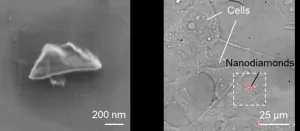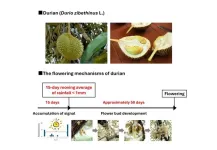(Press-News.org)
Quantum sensing is a rapidly developing field that utilizes the quantum states of particles, such as superposition, entanglement, and spin states, to detect changes in physical, chemical, or biological systems. A promising type of quantum nanosensor is nanodiamonds (NDs) equipped with nitrogen-vacancy (NV) centers. These centers are created by replacing a carbon atom with nitrogen near a lattice vacancy in a diamond structure. When excited by light, the NV centers emit photons that maintain stable spin information and are sensitive to external influences like magnetic fields, electric fields, and temperature. Changes in these spin states can be detected using optically detected magnetic resonance (ODMR), which measures fluorescence changes under microwave radiation. NDs with NV centers are biocompatible and can be designed to interact with specific biological molecules, making them valuable tools for biological sensing. However, NDs used for bioimaging generally exhibit lower spin quality compared to bulk diamonds, resulting in reduced sensitivity and accuracy in measurements.
In a recent breakthrough, scientists from Okayama University in Japan developed nanodiamond sensors bright enough for bioimaging, with spin properties comparable to those of bulk diamonds. The study, published in ACS Nano, on 16 December 2024, was led by Research Professor Masazumi Fujiwara from Okayama University, in collaboration with Sumitomo Electric Company and the National Institutes for Quantum Science and Technology.
“This is the first demonstration of quantum-grade NDs with exceptionally high-quality spins, a long-awaited breakthrough in the field. These NDs possess properties that have been highly sought after for quantum biosensing and other advanced applications,” says Prof. Fujiwara.
Current ND sensors for bioimaging face two main limitations: high concentrations of spin impurities, which disrupt NV spin states, and surface spin noise, which destabilizes the spin states more rapidly. To overcome these challenges, the researchers focused on producing high-quality diamonds with very few impurities. They grew single-crystal diamonds enriched with 99.99% 12C carbon atoms and then introduced a controlled amount of nitrogen (30–60 parts per million) to create an NV center with about 1 part per million. The diamonds were crushed into NDs and suspended in water.
The resulting NDs had a mean size of 277 nanometers and contained 0.6–1.3 parts per million of negatively charged NV centers. They displayed strong fluorescence, achieving a photon count rate of 1500 kHz, making them suitable for bioimaging applications. These NDs also showed enhanced spin properties compared to commercially available larger NDs. They required 10–20 times less microwave power to achieve a 3% ODMR contrast, had reduced peak splitting, and demonstrated significantly longer spin relaxation times (T1 = 0.68 ms, T2 = 3.2 µs), which were 6 to 11 times longer than those of type-Ib NDs. These improvements indicate that the NDs possess stable quantum states, which can be accurately detected and measured with low microwave radiation, minimizing the risk of microwave-induced toxicity in cells.
To evaluate their potential for biological sensing, the researchers introduced NDs into HeLa cells and measured the spin properties using ODMR experiments. The NDs were bright enough for clear visibility and produced narrow, reliable spectra despite some impact from Brownian motion (random ND movement within cells). Furthermore, the NDs were capable of detecting small temperature changes. At temperatures around 300 K and 308 K, the NDs exhibited distinct oscillation frequencies, demonstrating a temperature sensitivity of 0.28 K/√Hz, superior to bare type-Ib NDs.
With these advanced sensing capabilities, the sensor has potential for diverse applications, from biological sensing of cells for early disease detection to monitoring battery health and enhancing thermal management and performance for energy-efficient electronic devices. “These advancements have the potential to transform healthcare, technology, and environmental management, improving quality of life and providing sustainable solutions for future challenges,” says Prof. Fujiwara.
About Okayama University, Japan
As one of the leading universities in Japan, Okayama University aims to create and establish a new paradigm for the sustainable development of the world. Okayama University offers a wide range of academic fields, which become the basis of the integrated graduate schools. This not only allows us to conduct the most advanced and up-to-date research, but also provides an enriching educational experience.
Website: https://www.okayama-u.ac.jp/index_e.html
About Research Professor Masazumi Fujiwara from Okayama University, Japan
Dr. Masazumi Fujiwara is a Research Professor in the Department of Chemistry at the Graduate School of Life, Environmental, Natural Science, and Technology, Okayama University, Japan. With a background in physics (PhD from Osaka City University and postdocs at Hokkido University and the Humboldt University of Berlin), he leads the Nanochemistry Laboratory, focusing on the development of nanomaterials, their applications in biological studies and quantum nanophotonics. Prof. Fujiwara has received multiple awards, including the 2015 Masao-Horiba Award, the 2020 Osaka City University Nambu Yoichiro Award, and the 2016 MEXT Fellowship for Excellent Young Researchers. His team has been actively engaged in international collaborative research, with a particular focus on projects such as the JST-ASPIRE program (JPMJAP2339).
Website: https://www.nanochem-okayama-u.net/
Linkedin: https://www.linkedin.com/in/masazumi-fujiwara-779548194/
END
Key Takeaways
An expert workgroup representing primary and specialty care has developed new guidelines for comprehensive evaluation of patients who may have cognitive impairment or dementia due to Alzheimer’s disease or a related disease. Current guidelines for a comprehensive evaluation process are more than 20 years old.
Results of the evaluation should be a three-step diagnostic formulation, summarizing the patient’s overall level of impairment, a brief summary of the symptoms they are experiencing, and the likely underlying brain disease(s) and/or conditions contributing to their ...
Atlantic and Baltic herring are typical plankton-eating fish of central importance for the northern Atlantic Ocean and Baltic Sea ecosystems. A new study published in Nature Communications led by scientists from Uppsala University (Sweden) documents the discovery of the evolution of genetically distinct, fish-eating herring in the Baltic Sea, a young water body that has only existed since the end of the last glaciation.
Atlantic and Baltic herring have a key role in the ecosystem, acting as a critical link between plankton production and other organisms, like predatory fish, sea birds, sea mammals, and humans. Previous research from the Uppsala group has documented that herring is subdivided ...
Floating wind power offers enormous potential for deepwater offshore energy development. However, the management and secure exchange of data between stakeholders represents a key challenge for its evolution. A new cryptographic framework, proposed by researchers Claudia Bartoli (IMDEA Software) and Irene Rivera-Arreba (Norwegian University of Science and Technology, NTNU), presented at WindTech 2024 Conference, tries to solve this problem with a data sharing scheme that guarantees data integrity without compromising privacy. This breakthrough seeks to foster collaboration between industries and academia, driving innovation in floating wind technologies.
Context
Floating wind power ...
In a recent analysis of data from more than a dozen studies, coffee and tea consumption was linked with lower risks of developing head and neck cancer, including cancers of the mouth and throat. The findings are published by Wiley online in CANCER, a peer-reviewed journal of the American Cancer Society.
Head and neck cancer is the seventh most common cancer worldwide, and rates are rising in low- and middle-income countries. Many studies have assessed whether drinking coffee or tea is associated with head and neck cancer, with inconsistent results.
To provide additional insight, investigators examined data from 14 studies by different scientists associated with the International Head and ...
Age-related macular degeneration (AMD) is the leading cause of vision loss in individuals over 65, characterized by abnormal changes in the macular, resulting in reduced vision and distorted objects. Dry AMD accounts for 90% of all AMD cases, with relatively mild vision impairment; however, approximately 30% progress to the severe vision loss associated with wet AMD within 10 years. The only FDA-approved treatments for dry AMD as of 2023 are two injectable drugs, which are limited by concerns over complications from intravitreal injections and modest ...
Tokyo, Japan – Researchers from Tokyo Metropolitan University have discovered that around 15 days of dry weather can trigger the flowering of durian. Observations of 110 durian plants revealed that flowering occurred around 50 days after an approximately 15-day dry spell, independent of whether the plant was grafted or grown from a seed. The team’s work might not only impact the production of a valuable agricultural asset but deepen our understanding of tropical ecosystems.
Known in many countries as the “king of fruits,” the durian is known for its distinctive strong odor, large size, ...
As NASA’s Europa Clipper embarks on its historic journey to Jupiter’s icy moon, Europa, Dr. Matt Powell-Palm, a faculty member at Texas A&M University’s J. Mike Walker ‘66 Department of Mechanical Engineering, has unveiled groundbreaking research that could transform our understanding of icy ocean worlds across the solar system. The study published in Nature Communications, co-authored with planetary scientist Dr. Baptiste Journaux of the University of Washington, introduces a novel thermodynamic concept called the “centotectic” and investigates the stability of liquids in extreme conditions - critical ...
In the holiday movie The Grinch, makeup artists are reported to have spent several hours each day encasing Jim Carrey’s face with prosthetics to create the iconic grumpy, green-furred creature. Such elaborate prosthetics, often made possible by materials like silicone rubbers, may have now found an unexpected yet beneficial biomedical engineering application, according to a new study from Texas A&M University.
Published in the journal Scientific Reports, researchers have created realistic, skin-like replicas made of Ecoflex, a type of silicone rubber that can potentially serve as a platform to evaluate risks of bacterial infections from ...
A research team co-led by a physician-scientist at the University of Arizona College of Medicine – Tucson’s Sarver Heart Center found that a subset of artificial heart patients can regenerate heart muscle, which may open the door to new ways to treat and perhaps someday cure heart failure. The results were published in the journal Circulation.
According to the Centers for Disease Control and Prevention, heart failure affects nearly 7 million U.S. adults and is responsible for 14% of deaths per ...
In 2022 alone, over 20 million people were diagnosed with cancer, and nearly 10 million died from the disease, according to the World Health Organization. While the reaches of cancer are massive, the answer to more effective treatments may be hidden within a microscopic cell.
Led by Texas A&M University graduate students Samere Zade of the biomedical engineering department and Ting-Ching Wang of the chemical engineering department, an article released by the Lele Lab has uncovered new details about the mechanism behind cancer progression.
Published in Nature Communications, the article ...







